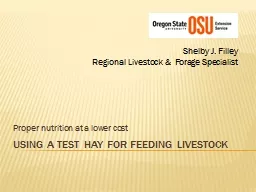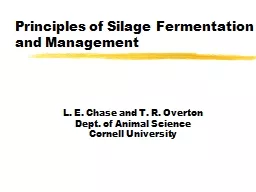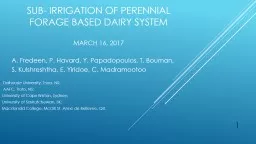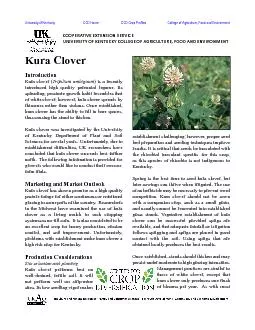PPT-FORAGE
Author : lois-ondreau | Published Date : 2016-08-01
SCIENCE Facof A nimal H usbandry Brawijaya U niversity GRASS Axonopus compressus P Beauv Synonim P aspalum compressum Sw Nees Paspalum platycaule Willd ex
Presentation Embed Code
Download Presentation
Download Presentation The PPT/PDF document "FORAGE" is the property of its rightful owner. Permission is granted to download and print the materials on this website for personal, non-commercial use only, and to display it on your personal computer provided you do not modify the materials and that you retain all copyright notices contained in the materials. By downloading content from our website, you accept the terms of this agreement.
FORAGE: Transcript
SCIENCE Facof A nimal H usbandry Brawijaya U niversity GRASS Axonopus compressus P Beauv Synonim P aspalum compressum Sw Nees Paspalum platycaule Willd ex Steud . FORAGEFACTS Research and ExtensionTable 1. Level of prussic acid in forage (dry matter basis) andppm HCNEffect on animals0 For . Goats Production. Ken Andries. Kentucky State . University. College of Agriculture, Food Science, and Sustainable Systems. Importance of Forage. Goats are Ruminant Animals. Efficient at converting high fiber diets to high quality protein.. forage contingencies. John Dhuyvetter. NCREC. Forage . Situation. Stockpile roughage. Other sources. Stretching supply. Reducing need. Headlines. Japan to accept beef under 30 months. Feedlot placements lower than expected. . an Alternate . Forage Option . Dr. Mike Hutjens. Dairy Extension Specialist. University of Illinois at Urbana-Champaign. Jim Baltz. Instructional Design Specialist. Learn Objective. The growing and feeding of a fall cereal grain can be a viable forage resource. Hay . for Feeding Livestock . Shelby J. . Filley. Regional . Livestock & Forage Specialist. Proper nutrition at a lower cost . Objectives. Understanding a Hay . Analysis Report. Matching Nutrient Supply & Demand. L. E. Chase and T. R. Overton. Dept. of Animal Science. Cornell University. What is Silage?. “The feedstuff resulting from the . anaerobic. preservation of moist forage or other feeds by the formation and/or addition of acids”. Neibergs. and Jon Paul Driver. Western Center For Risk Management Education. Forage Risk Management. Disclaimer: This information is provided for training only. Any discrepancy between the training material and the policy is not intended. The information provided in this training does not supersede policy and procedure. . Dennis Hancock. Extension Forage Specialist. UGA – Dept. of Crop and Soil Sciences. 2015 . Georgia Grazing School. Yield Distribution of Tall Fescue Complemented with Bermudagrass in Athens, GA. Surplus. March 16, 2017. . A. Fredeen, P. . Havard. , Y. Papadopoulos, T. . Bouman. , . S. . Kulshreshtha. , E. . Yiridoe. , C. . Madramootoo. . Dalhousie University, Truro, NS;. AAFC, . Troro. , NS;. University of Cape Breton, Sydney; . Mr. Joshua A. White. -Research Associate. Dr. Rocky . Lemus. - . Forage Extension Specialist. Dr. David Lang- Forage Research . Profressor. Acres Distribution . . Summer Annuals. Sorghum, corn silage, . Mr. Joshua A. White. -Research Associate. Dr. Rocky . Lemus. - . Forage Extension Specialist. Dr. David Lang- Forage Research . Profressor. Acres Distribution . . Summer Annuals. Sorghum, corn silage, . Dr. Mike Hutjens. Dairy Extension Specialist. University of Illinois at Urbana-Champaign. Jim Baltz. Instructional Design Specialist. Learning Objectives. After viewing this module you should be able to:. when cattle graze on pure stands, but a forage grass sown into established kura clover stands can help reduce this problem. This legume will go dormant during periods of drought, resuming growth o when cattle graze on pure stands, but a forage grass sown into established kura clover stands can help reduce this problem. This legume will go dormant during periods of drought, resuming growth o
Download Document
Here is the link to download the presentation.
"FORAGE"The content belongs to its owner. You may download and print it for personal use, without modification, and keep all copyright notices. By downloading, you agree to these terms.
Related Documents














